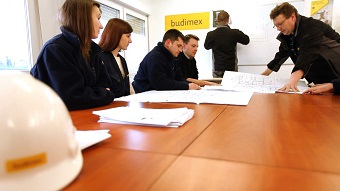Business Environment
General market conditions
 WATCH MOVIEConstruction of Libra Business Center
WATCH MOVIEConstruction of Libra Business Center in Warsaw - time lapse
In 2012, Poland experienced an economic downturn. A particularly noticeable slowdown occurred in the construction industry, where it was reflected in the financial position and market valuation of most construction companies, as well as delays in most projects, particularly infrastructural projects. The significant worsening of the situation in the construction industry is illustrated by the index of the overall business situation, which in December 2012 was at its lowest level since January 2003.
An initial reading of GDP movements in 2012 indicates an increase of 2.0% over 2011 (in 2011, GDP growth was reported at 4.3% year-on-year). Despite worsening market conditions, Poland continues to be perceived as a country with a stable foundation and a relatively solid public finance structure.
After rapid growth in 2011 (16.3% compared to 2010, in terms of fixed prices), the past year has seen a slowdown in construction and assembly production. The industry has decreased by 1.0% over the course of the year, mainly due to the dwindling of infrastructural projects, which had been driving growth in previous years.
Expenditures by the key investor in the roads segment, the General Directorate for National Roads and Highways (Generalna Dyrekcja Dróg Krajowych i Autostrad – GDDKiA), decreased from the record-high level of PLN 26.4 billion in 2011 to approximately PLN 22.6 billion in the prior year. Lower expenditure was mainly caused by delays and the need to reissue road construction tenders (e.g. in the case of A1 and A4 highway sections for which agreements with contractors had been terminated).
The share of civil and water engineering facilities in the structure of construction and assembly production decreased from 60.1% in 2011 to 55.3% in 2012, mainly due to an increased share of residential construction (from 39.9% to 44.7%).
After a three-year downward trend, in 2012, the number of flats handed over for use increased, reaching 152.5 thousand. On the other hand, the extensive housing offer and anticipated decreased demand (due to market uncertainty and the dwindling of the “Rodzina na Swoim” scheme) had a negative impact on the number of flats offered for sale which are under development (an 11.3 per cent decrease compared to the prior year). The number of flats for sale, for which building permits had been issued, decreased in 2012 by 11.7% compared to the prior year, reflecting developers’ unwillingness to commence any new projects.
Market development perspectives

Market conditions in the years 2013-2014 most likely will not be favourable for the construction industry. In accordance with the provisions of the Act on State Budgets, the increase in GDP in 2013 should be 2.2%, and the yearly average inflation rate - 2.7%. The unemployment rate at year-end is projected to be 13%. Although most projections envision an improvement in the economic situation in the latter half of 2013, medium-term growth prospects for the construction market tend to be pessimistic.
The greatest challenges are expected in the roads segment. Although GDDKiA estimates it will spend PLN 18 billion in 2013, it is expected that the number of new public tenders will be further limited, which will translate into a decrease in the value of the roads market, in particular in the year 2014. The “Polish Investments” project, which will help finance the development of, among other things, the missing section of the A1 highway (between Tuszyn and Pyrzowice) may help revive the segment. The estimated value of the 140 km project is approximately EUR 2 billion, and the first tenders may be announced as early as the middle of this year.
Railway infrastructure projects are expected to experience growth in coming years. In accordance with the data contained in the Multi-year Railway Investment Plan until 2015, prepared by the Ministry of Transport, Construction and Maritime Economy, the expenditures of PKP PLK (the main investor in said segment) in 2012 amounted to PLN 3.7 billion, whilst in 2013, they are to reach PLN 7.7 billion. The PLN 11 billion threshold is expected to be exceeded in 2014.
Last year saw the conclusion of the first, long-awaited tenders for the construction of new power units (such as the Opole and Kozienice units). Most market experts agree that the energy construction industry will be the fastest growing construction market segment in the coming years.
2013 might prove to be a particularly challenging time for development companies. The extensive offer of the primary market, together with the anticipated economic slowdown (negatively affecting the decisions of key customer groups) may result in fierce competition and even fiercer battle for customers, particularly among companies heavily relying on external financing.
The business operations of the Budimex Group companies focus on the construction sector, which to a large degree uses aid funds obtained from the European Union. A large part of these funds is assigned to infrastructural projects, including the construction of roads and railways. In the coming years, the final budget of EU funds for Poland for the years 2014-2020 will be the key parameter for the development of the construction market. Under the agreement concerning the new budget, Poland may expect EUR 72.9 billion under the Cohesion Policy, i.e. more than the 2007-2013 allowance.